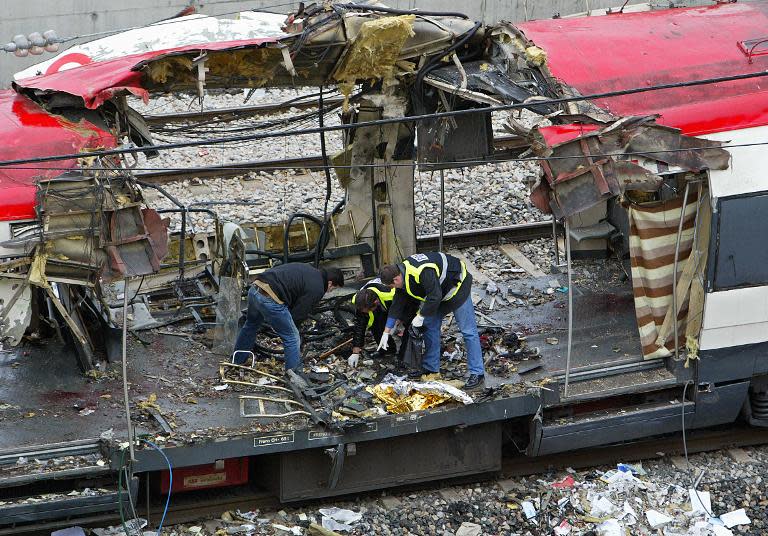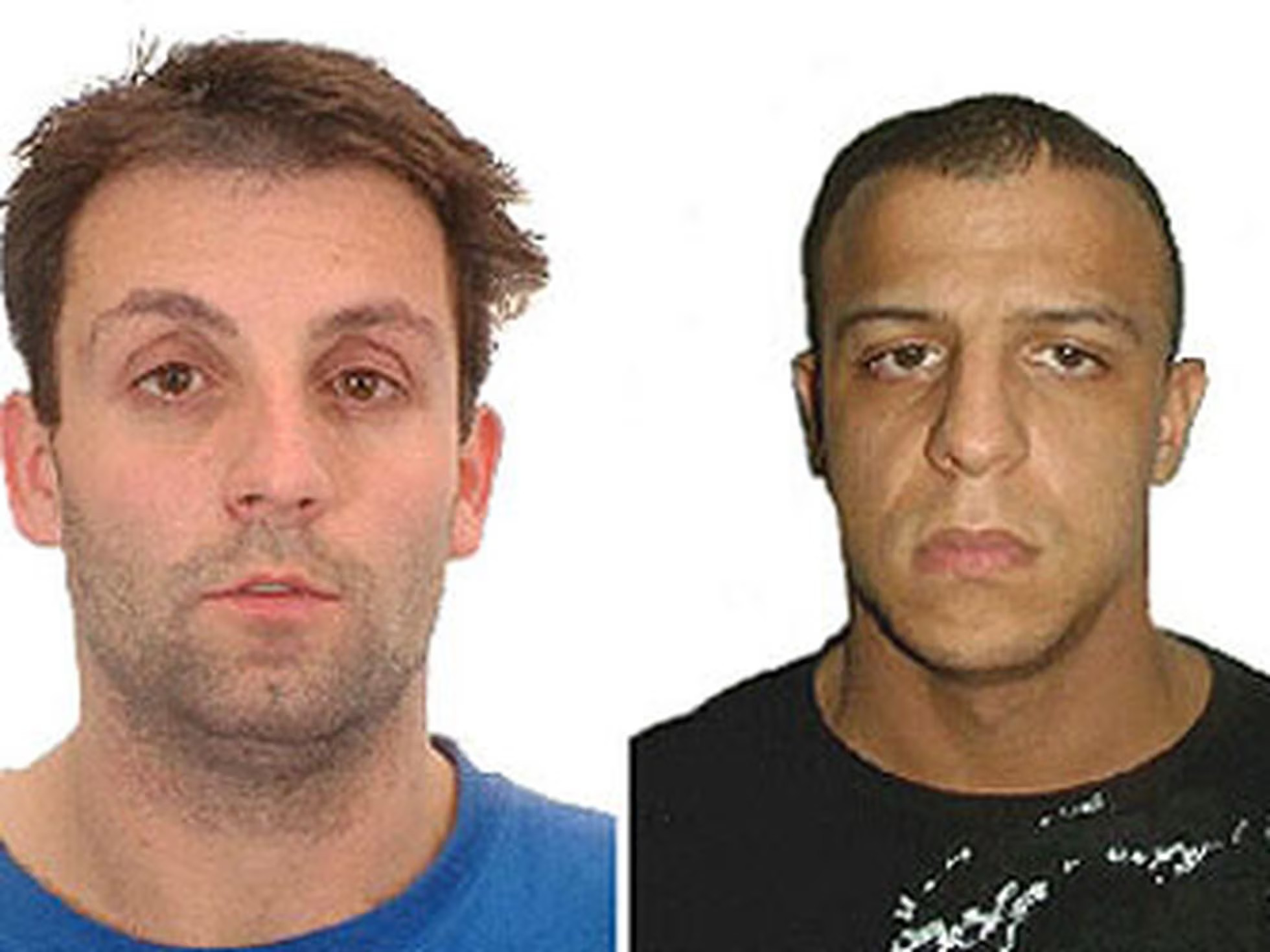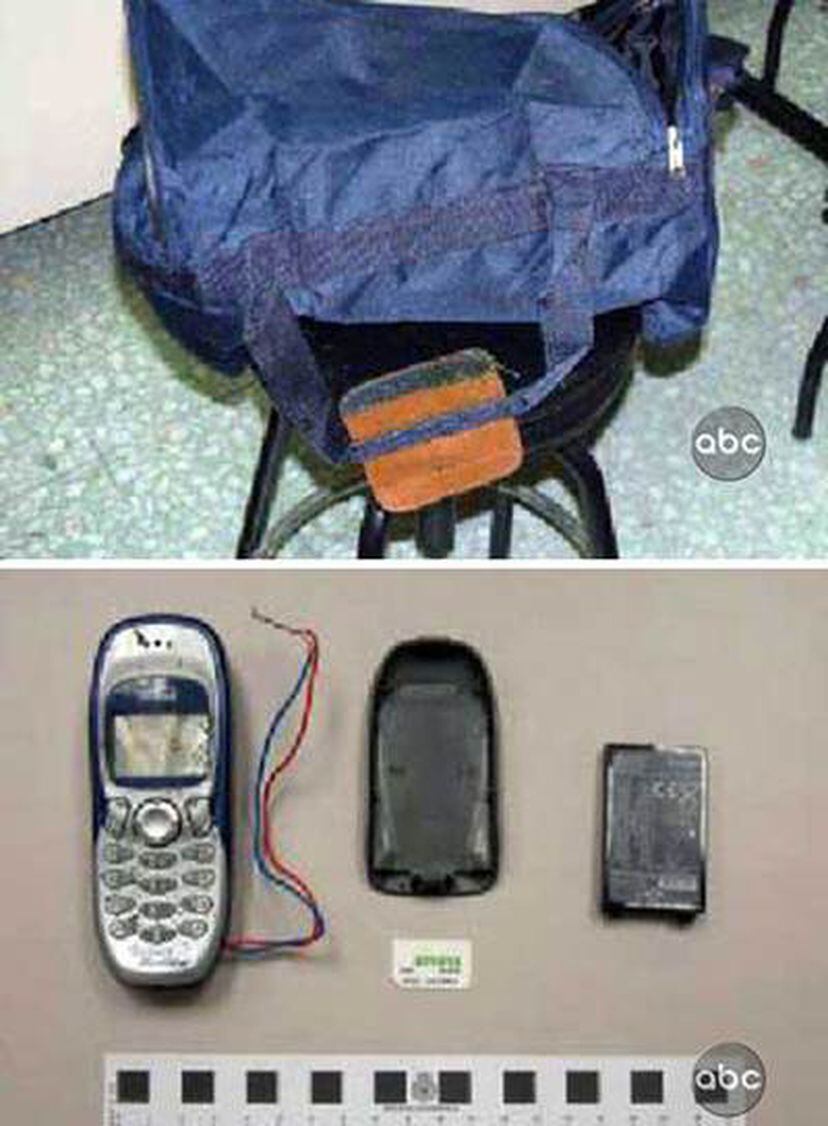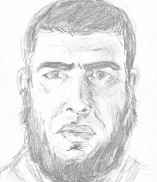
Madrid Train Bombings

The remains of a train which was bombed at the Madrid station of Atocha
As the story goes, on March 11th, 2004 a total of four trains were bombed by Al-Qaeda in Madrid - one at the Atocha Station, El Pozo del Tío Raimundo Station, Santa Eugenia Station and Calle Téllez station, killing 193 and wounding 2,050. The attack was deemed to be in response to Spanish support for the US led invasion of Iraq.
Sooner rather than later though, people started to ask questions, one of the first things that people brought up was that NATO was conducting it's annual crisis management exercise (CMX 2004) which lasted from March 4th to
March 10th, the bombing happening a day after it ended, this exercise involved all of the, at the time, 19 member countries. Spain had been the 16th country to join NATO on May 30th, 1982.
A major breakthrough was made two years after the Madrid train bombings in 2006 in which it was determined that the attacks were not at the behest of Al-Qaeda but instead were committed by "homegrown terrorists", an
excerpt from an article describing this reads as follows:
"A two-year probe into the Madrid train bombings concludes the Islamic terrorists who carried out the blasts were homegrown radicals acting on their own rather than at the behest of Osama bin Laden's al-Qaida network, two senior intelligence officials said.
Spain still remains home to a web of radical Algerian, Moroccan and Syrian groups bent on carrying out attacks - and aiding the insurgency against U.S. troops in Iraq - a Spanish intelligence chief and a Western official intimately involved in counterterrorism measures in Spain told The Associated Press.
The intelligence chief said there were no phone calls between the Madrid bombers and al-Qaida and no money transfers. The Western official said the plotters had links to other Islamic radicals in Western Europe, but the plan was hatched and organized in Spain. 'This was not an al-Qaida operation,' he said. 'It was homegrown.'
Both men spoke on condition of anonymity, the first because Spanish security officials are not allowed to discuss details of an ongoing investigation, the second due to the sensitive nature of his job.
The attack has been frequently described as al-Qaida-linked since a man who identified himself as Abu Dujan al-Afghani and said he was al-Qaida's 'European military spokesman,' claimed responsibility in a video released two days later."
One of the first real bombshells in the case though was actually before this in 2004 when it was exposed that the suspects Rafa Zuher and Jose Emilio Suarez which were said to have provided explosives to the bombers turned out to be police informants.

Jose Suarez (left) and Rafa Zahar (right)
The article describing this is rather short so I'll just post it all here for the sake of this report:
"The Spanish interior ministry says it is investigating reports that two suspects in the 11 March Madrid train bombings were police informants.
The move came after Spain's El Mundo newspaper said Moroccan Rafa Zuher and Spaniard Jose Emilio Suarez had been in contact with police before the attacks.
The men are suspected of providing dynamite for the attacks, which killed 191 people and injured more than 2,000.
The paper said they passed on details about drug deals and other crimes.
Mr Suarez, a former miner, was arrested a week after the attacks and is the only Spanish-born suspect in custody.
According to El Mundo, he was an informant for the National Police, providing information about trafficking in weapons, drugs and explosives.
The paper said Mr Zuher, who was arrested later in March, had passed on information to the Civil Guards in Madrid about low-level drug deals involving hashish and ecstasy.
El Mundo, citing security sources for its report, said Mr Zuher was believed to be the link between Mr Suarez, who allegedly supplied the explosives, and the cell that carried out the attacks.
After the report was published, the Spanish interior ministry issued a statement saying it had ordered an investigation.
The ministry said that if necessary, the results of the inquiry would be handed over to a judge."
An analysis that came directly from Spain was from the news outlet El Mundo which brought up a few questions about the bombings that didn't seem to add up, it was however eventually brought to the knowledge of the English speaking world via a post made by the Spanish blogger Franco Alemán, highlights from the post are listed below:

A photo of what is supposedly 'Backpack 13' and it's contents
- Questions have been raised about the actual provenance of a knapsack dubbed 'Backpack 13' and its contents (plastic explosive, a cell phone used as a trigger, and nails and bolts that would act as shrapnel to maximize the bomb's destructive effect). Shortly after the 3/11 attack, ABC News showed what it claimed as 'exclusive' footage of both the purported backpack and its unexploded innards. Alemán’s posting says:
- Alemán says the journalistic investigation revealed that 'the Tedax officers hid for three months [from] the investigating judge that an X-ray done to the real (not to the [one] staged for ABC) backpack showed that there was no way it could have ever exploded since it had unconnected cables. Something odd, since it had always been said that the bombers were technically proficient.'
- It seems that a phonebook belonging to Carmen Toro, allegedly one of the men who supplied the explosive used in the 3/11 attacks, contained the cellphone number for Tedax's chief. What is more, Alemán’s posting incredulously recounts how, 'When the investigating judge called the number, a chief's aide answered the phone and said that it belonged to one of the guys in the squad, 'who used the boss' name as a nickname.'"
- The claim that the Aznar government wrongly - and for political reasons - initially blamed ETA for the attacks rests on two propositions derived from Backpack 13's contents: The nature of the explosive and evidence associated with its cellphone trigger.
- The type of explosive found in the alleged bombers' backpack was a plastic known as Goma 2 ECO, rather than the Tytadine that ETA had employed in its prior attacks. Alemán notes, however, that 'the conclusion that the exploded backpacks had Goma 2 ECO in it was made because of what was found on the unexploded one - not on actual forensic analysis of the explosion site, since apparently once it's gone off it's absolutely impossible to know for sure, [since] both Goma 2 ECO and Tytadine [are] two brands of generic dynamite."
- The phone provided three pieces of incriminating evidence. First of all, on it were found to the fingerprints of one Jamal Zougam, the ringleader of the Islamist "Lavapies" cell now blamed for the Madrid attack.
Second, the phone was supposed to be activated by its alarm and then vibrate, causing the plastic explosive to detonate. Since the bombers apparently made a novice's mistake by failing to connect the wires from the phone to the explosive with electrical tape, even the slightest movement of the backpack would likely prevent the cellphone’s signal from setting off the bomb.
Even more curious is the fact that the phone in the Backpack #13 was a Mitsubishi Trium, one of very few on the market that require a SIM card to operate the alarm. Since, as Alemán notes, "it was the analysis of the SIM card which, less than 48 hours after the blasts, allowed the police to arrest the alleged perpetrators," the question occurs: Why would terrorists who owned a cellphone shop and are deemed to be very technically proficient deliberately choose to use a device that would lead the police to their door? - Speaking of cellphones, the Alemán blog titillates readers by offering further details from the unfolding El Mundo investigation. He reports that:
"According to reporter Fernando Múgica in the Spanish daily El Mundo. According to Múgica, at a Madrid police station 'the officers wanted to help the ABC reporters, but when the camera crew came, they didn't have the backpack that had contained the bomb there, so one of the officers showed them a similar backpack which was the property of another officer.' Said Mugica, 'I don't know whether the network knew this or simply accepted that the bag they were shown was the real one.'"
"Cellphones used for March 11 were unlocked in a phone shop owned by... a Spanish police officer. And not just any police officer: It was Maussili Kalaji, a Syrian born citizen who had been granted Spanish citizenship several years ago and entered the police department when he arrived in Spain [despite] his past as an Al Fatah member and as an agent for the Soviets' intelligence services.
Apparently as soon as [Kalaji] left the [Spanish] police academy, he was assigned to infiltrate extremist groups and so he got acquainted with such nice guys as Abu Dadah, currently under trial for the 9/11 plot and who will be on trial again in the future for his role on March 11. He also was assigned to the security detail of Judge Garzón, now on leave and teaching at a New York university - who insisted that, no matter what Aznar was saying on March 11, he knew from minute 1 that…the bombings had been by Islamic terrorists, not ETA. I think we know now why.
And that's not all: Kalaji's sister was the translator for the police in charge of translat[ing] the wiretapped conversations between the alleged March 11 culprits before the bombings. And his ex-wife, also a police officer, was the first to arrive at the scene where another key [piece of] evidence pointing to Islamic terrorists and not ETA was found: a white van with detonators and some tapes with Koranic verses. Socialists blame Aznar's government for hiding this but, of course, maybe its guys got there first...."
The report by El Mundo and subsquent editorial reveal a lot of damning details about the Madrid train bombings which wouldn't otherwise have made it outside of Spain if it wasn't for Franco Alemán, so major props to him for that.
But there's still more to unpack here. It was reported by José Luis Rodríguez Zapatero, the successor to José María Aznar, that all of the records referring to the Madrid train bombings were wiped from the computers in the
Prime Minister's office, including emails, security copies and any backups, but why? No one is quite sure, but it definitely reeks of a government cover-up.

A sketch of Abdelkader el Farssaoui
More damning information comes from a Moroccan informant named Abdelkader el Farssaoui (Cartagena) who informed the Central Unit of Foreign Information (UCIE) that Islamists intended to commit terror attacks in Spain and
Morocco, notes dated from October 2002 to February 2004 show that the attack was most definitely not unknown of by the Spanish government.
Infact the notes provided imply that the Spanish police knew of the plot entirely and controlled the bombers which carried out
the attacks to begin with, they will be listed below, translated from Spanish to English of course:
- The first meeting with Imam Abdelkader el Farssaoui, who offers to collaborate with the police by providing information on the different Islamist groups based in Madrid and their members in exchange for protection and money, is recorded.
- The UCIE already uses the code name 'Cartagena' when referring to El Farssaoui. And, in addition, it also includes who is the visible head of Haraka Salafiya - the Moroccan Maimouni -, the activities of El Egipcio, El Tunecino, Ben Sellam, the cell phones they use and the most radical mosque in Madrid, the one in Estrecho.
- It is reflected that "jihad can be carried out in countries such as Morocco and Spain", and much more information is provided about El Egipcio and El Tunecino. It also appears a vehicle that will be key in the whole plot of 11-M, the Volkswagen M-0025-WP that later would appear abandoned in Leganés.
- This fourth note from the UCIE is used by Cartagena to alert the police to the importance of a call shop in Lavapiés and the contacts it has with Najib Chaib's wife.
- The UCIE includes in its fifth note the marriage between a sister of Mustapha Maimouni (arrested in Morocco for the Casablanca attacks) and El Tunecino (leader of the Lavapiés commando).
- This note is one of the weakest provided by Cartagena, where it is limited to providing some more information about El Egipcio.
- This report gives a sense of uneasiness and insecurity around Mustapha's group and the location of two Moroccans, Jamal Zougam and Mohamed Chaoui, who will be fundamental pieces in the Lavapiés commando. It also reflects the relations and contacts of the lawyer Yamila Pardo Candelas, Joaquín Almunia's sister-in-law, who converses with the Islamist radicals.
- He refers to car trafficking, new imams, a new lawyer working with Islamists and some information about the Lavapiés call shop.
- This note focuses very well on the personality and leadership capacity of El Tunisian. "Within the group he believes that Mustapha is not the leader, Mustapha follows the Algerian brothers Nasereddine and Azeddin. He leans as leader to Sarham El Tunecino, married to a sister of Mustapha Maimouni, whose wedding he attended as a witness. Of whom he says: very educated, he has a degree from a Spanish university, he believes in Physics".
- Cartagena moved to Salobreña, where he found work: "In Salobreña (Granada) he has created an association that brings together a large number of Moroccans and some converted Spanish families, specifically four doctors, one from Madrid and another who lives in Motril, coming from Malaga".
- On this occasion, 'Cartagena' provides a lot of information about his old contacts and new ones: "A certain Rachid, a young Moroccan who belongs to a Salafist group, dedicated in Tirso de Molina to the wholesale of false clothes, frequently receives a certain Karim, a Moroccan, of the same Salafist current, who supplies Rachid with clothes that he brings from Portugal, but with him he also maintains non-commercial contacts".
- Cartagena, settled in Roquetas de Mar, does not get a job. Shortly after he travels to Barcelona and after some contacts he gets help for his work in Roquetas.
And he is being introduced among the Islamists: "We are waiting for him to be centered within the resident colony in the province, as well as contacts that are being made to be able to know the different networks of illegal immigration and document forgery that operate in the area, without abandoning the relationships with like-minded people or members of radical Islamic movements".
Everything from the bombing suspects being police informants to the phones being used in the bombing being activated by a Spanish police officer showcase that the official story of the Madrid train bombings as we know it is a complete lie, from start to finish the entire operation was (most likely) planned by the Spanish government with the backing of NATO to support the Islamic terrorist scare which would continue to grow in strength with the 7/7 bombings a year later.
Return to False Flag Reports